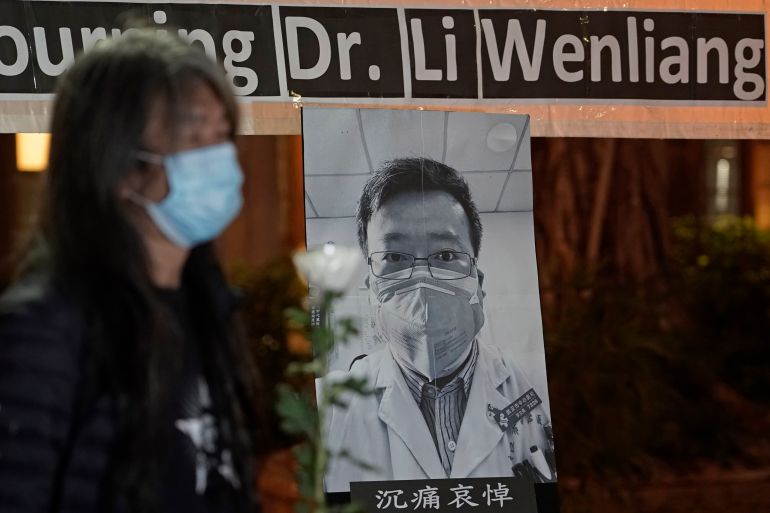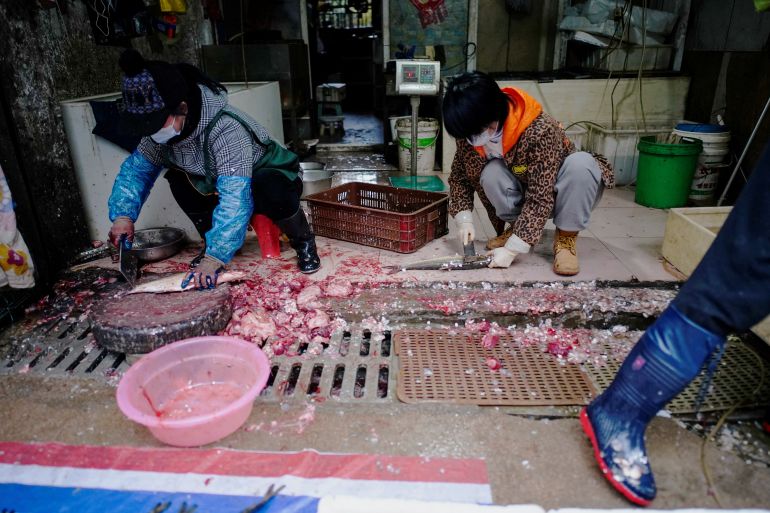![]() [Nataliia Shulga/Al Jazeera]
[Nataliia Shulga/Al Jazeera]
Sun 12 March 2023:
Scientists lean towards a natural spillover from animals, but China’s opacity means a lab leak can’t be ruled out.
The virus was first detected in Wuhan, China in late December 2019, and was quickly linked to the Huanan Seafood Wholesale Market. But as cases began to grow, health authorities in Wuhan scrubbed the market clean by January 1, 2020.
Removed from the market were the exotic wildlife, such as raccoon dogs and bamboo rats, that many scientists believe were the intermediary step between horseshoe bats – a common reservoir for coronaviruses and endemic to the area around Wuhan – and COVID-19’s jump to humans. Critical information has been missing from the start of the investigation and China has refused to give the WHO and other researchers full access to the remaining data.
In the place of answers are competing narratives.
On one end of the spectrum, there is evolutionary biology, which supports a natural or “zoonotic” outbreak. On the other end are those who believe it may have accidentally leaked from the Wuhan Institute of Virology, which lies less than a kilometre from the market and is known to handle dangerous pathogens. For them, compelling evidence lies in the fact that similar accidents have happened before in Taiwan, China and Singapore. Near misses have also been reported at labs in the United States, including at the University of North Carolina at Chapel Hill.
Conspiracy theorists and a few pundits believe that COVID-19 may have been a bioweapon, released by either the US or China depending on their political leanings.
The short answer: Scientists and other experts appear to skew towards believing in a natural cause — that the virus indeed spread from animals to humans. But China’s opacity has led to a dearth of evidence from the period, which, in turn, has kept scientists from making any definitive conclusions and has generated conspiracy theories.

People at a vigil for Chinese doctor Li Wenliang, in Hong Kong, on Friday, February 7, 2020. Li, who was reprimanded for warning about the new virus, died from related illnesses himself [File: Kin Cheung/AP Photo]
‘Solid evidence China was hiding’
Questions about the origin of COVID-19 have gained new urgency in recent weeks amid a slew of headline-grabbing suggestions emerging from US authorities.
In early February, the US Department of Energy’s intelligence agency said with “low confidence” that it believed the virus originated from a lab leak, based on undisclosed information. Shortly afterwards, FBI Director Christopher Wray also said the bureau has “for quite some time now, assessed that the origins of the pandemic are most likely a potential lab incident in Wuhan”, even though four other US intelligence agencies and the National Intelligence Council had previously concluded with “low certainty” that the virus emerged naturally.
But while lab leak theories have become highly politicised, especially with the geopolitical tensions between the US and China, concerns about Beijing’s lack of transparency on COVID-19 origins date back to the start of the crisis.
Besides removing valuable evidence at the Huanan market, China also did not officially declare the virus contagious through human-to-human transmission until January 20, 2020, even though its epidemiologists began using advanced monitoring techniques in late December as infections from the unknown virus grew. This became clear in a study published in the New England Journal of Medicine in March 2020 by Chinese researchers, based on data from 425 collected cases between December 10 and January 4.
“Had they disclosed the contagious nature earlier, we would not be in this pandemic at all,” Chi said.
Other factors fed suspicions about China’s actions, too.
Two different strains of COVID-19 were discovered early on in the pandemic, known as “Lineage A” and “Lineage B,” suggesting that the virus had been circulating for long enough to mutate. Another question was the fact that three lab workers from the Wuhan lab reportedly sought medical treatment in November 2020, according to a US intelligence report seen by the Wall Street Journal, although it is not uncommon in China to seek primary care at a hospital for relatively minor complaints.
China also punished whistleblowing doctor Li Wenliang who first warned about the new virus. Beijing earned further bad press when it appeared to stonewall an investigation by the WHO in 2021, whose results were inconclusive.

The Huanan Seafood Wholesale Market, where many scientists believe COVID-19 originated, sits closed in Wuhan in central China’s Hubei province on January 21, 2020 [File: Dake Kang, File/AP Photo]
Natural spillover ‘most probable answer’
In May 2021, a group of prominent scientists, including Michael Worobey, an evolutionary biologist at the University of Arizona, and Jesse Bloom, a virologist and professor at the Fred Hutchinson Cancer Center in Seattle, called for further study into COVID-19’s origins. Their signed letter in the journal Science did not dismiss an accidental lab leak as a possible cause.
One study, led by Jonathan Pekar, a PhD candidate in biomedical informatics at the University of California San Diego, focused on the molecular epidemiology of COVID-19 and looked at how the virus could have emerged.
The study appeared to explain the parallel existence of the two early strains of COVID-19, arguing that it is not atypical for viruses to make multiple failed attempts to jump to humans before a success. Many people passed through Wuhan’s Huanan market, where what came to be known as Lineage B was likely first transmitted to them around November 18, 2019, before Lineage A made the jump to humans “within weeks,” that study concluded.
A second international study published the same day and led by Worobey, also strongly suggested that the Huanan market was the epicentre of the outbreak. Using data gleaned from social media, the study mapped the residential locations of early patients and found they were clustered around the market.
Adding to the body of evidence in support of a “zoonotic spillover” has been the fact that throughout the pandemic there were multiple cases of the virus transmitting from humans to animals like minks, deer, cats and dogs. In Hong Kong, a batch of imported Syrian hamsters gave their owners COVID-19 that they had likely picked up in transit.
“No other explanation, including a laboratory origin at the Wuhan Institute or the Wuhan Center for Disease Control and Prevention, is consistent with the existing body of evidence,” she wrote in a Washington Post opinion piece this week alongside Saskia Popescu, an infectious-disease epidemiologist at George Mason University.
Other experts agreed that a zoonotic transfer of the virus to humans is the most likely explanation, but are more cautious about ruling out any other possibility.
“There is quite considerable evidence of a naturally occurring spillover. And the vast majority of novel outbreaks start naturally,” Lawrence Gostin, faculty director at Georgetown University’s O’Neill Institute for National & Global Health Law, told Al Jazeera.
“That is the most probable answer, but we will never know without greater access to both the market and the lab in Wuhan,” he said.

A security official moves journalists away from the Wuhan Institute of Virology in Wuhan in China’s Hubei province on Wednesday, February 3, 2021 [File: Ng Han Guan/AP Photo]
Lab-leak ‘plausible’
However, not everyone, even among scientists, is convinced that a natural spillover is necessarily the most likely source of the virus among humans.
Richard Ebright, a molecular biologist and director of the Waksman Institute of Microbiology at Rutgers University in New Jersey, has pushed back since early 2020 against those who call the lab-leak theory “conspiratorial”.
Now, he told Al Jazeera, he doubts that the virus emerged from the market in Wuhan even more than he did then.
“In the three years since that time, no new scientific data have become available relevant to the matter,” he said. “However, during that time, much new circumstantial evidence has become available on the high-risk virus enhancement research that was performed at the Wuhan Institute of Virology.”
Wuhan was the first lab in China certified to deal with the most dangerous pathogens in the world, including the deadly Ebola virus. The lab is also well known for its research on coronaviruses found in bats.
For scientists and intelligence agencies that do lean towards a “lab leak”, there is no evidence or suggestion that it would have been anything other than an accident. There are no credible theories that it was either intentional or a bioweapon.
To some experts, these differences among scientists over the possible causes of COVID-19 ironically offer a chance for consensus around the need for better safety standards both at bio labs and in wet markets like the one in Wuhan.
“There have been many lab leaks in the past, there have been many spillover events in the past – it is important to invest in measures around pandemic prevention in general on both sides,” said Thomas Bollyky, director of the Global Health Program at the Council on Foreign Relations.
Yet he acknowledged that this would “need global cooperation, and it is important that we pursue this investigation in a way that is ultimately going to advance this goal”.
At the moment, that goal appears increasingly remote.

Fish vendors prepare fish for sale at a wet market in Wuhan, Hubei province, China, on December 7, 2020. Many coronaviruses have spread from animals to humans, and some experts believe wet markets need better safety standards [File: Aly Song/Reuters]
Science v geopolitics
Many scientists have argued it is vital to keep probing how the virus first reached and spread among humans to learn lessons critical to preparing for future public health crises.
Since the 2000s, there have been multiple zoonotic spillovers, including severe acute respiratory syndrome. More recently, some scientists have warned that the seemingly unchecked mammal-to-mammal transmission of bird flu ravaging poultry populations globally was a cause for concern to humans, too.
“It’s important to continue to pursue this question,” Oregon State University’s Chi said. “But at the same time, we need to understand that for the foreseeable future, we will not get to the bottom of it.”
That has little to do with science and everything to do with how China sees its relations with the world, suggested Bollyky. “The consequences from determining the origin of this pandemic are likely to be geopolitical – exclusively geopolitical,” he told Al Jazeera. “It is really a reputation issue.”
This month Nature magazine reported that the second phase of a WHO study into the origins of COVID-19 has been “quietly shelved” despite warnings from its original team of researchers in August 2021 that the “window of opportunity for conducting this crucial inquiry is closing fast”. Both WHO Director-General Tedros Ghebreyesus and the expert leading the agency’s COVID-19 response, Maria Van Kerkhove, denied Nature’s accusation, with the latter attributing it to “an error in reporting, which is really quite concerning because it’s causing some headlines that are inaccurate.”
“We may never know for sure what caused the greatest human crisis of our lifetime,” Gostin said. “After all, we have suffered as a world.”
“We deserve clear answers.”
___________________________________________________________________________________________________________________________________
FOLLOW INDEPENDENT PRESS:
TWITTER (CLICK HERE)
https://twitter.com/IpIndependent
FACEBOOK (CLICK HERE)
https://web.facebook.com/ipindependent
Think your friends would be interested? Share this story!





